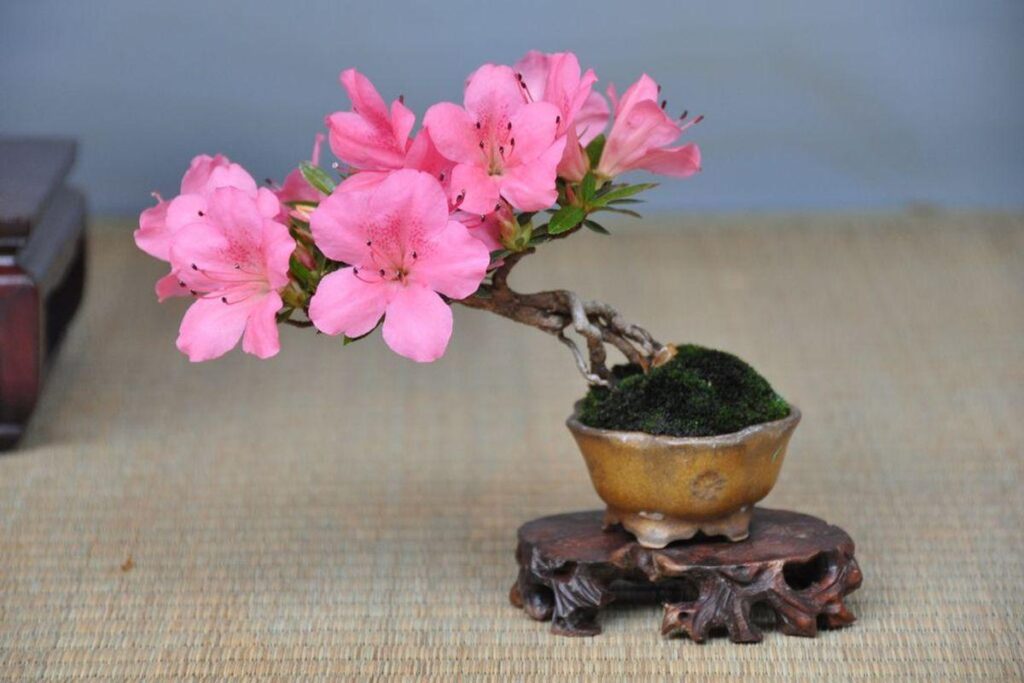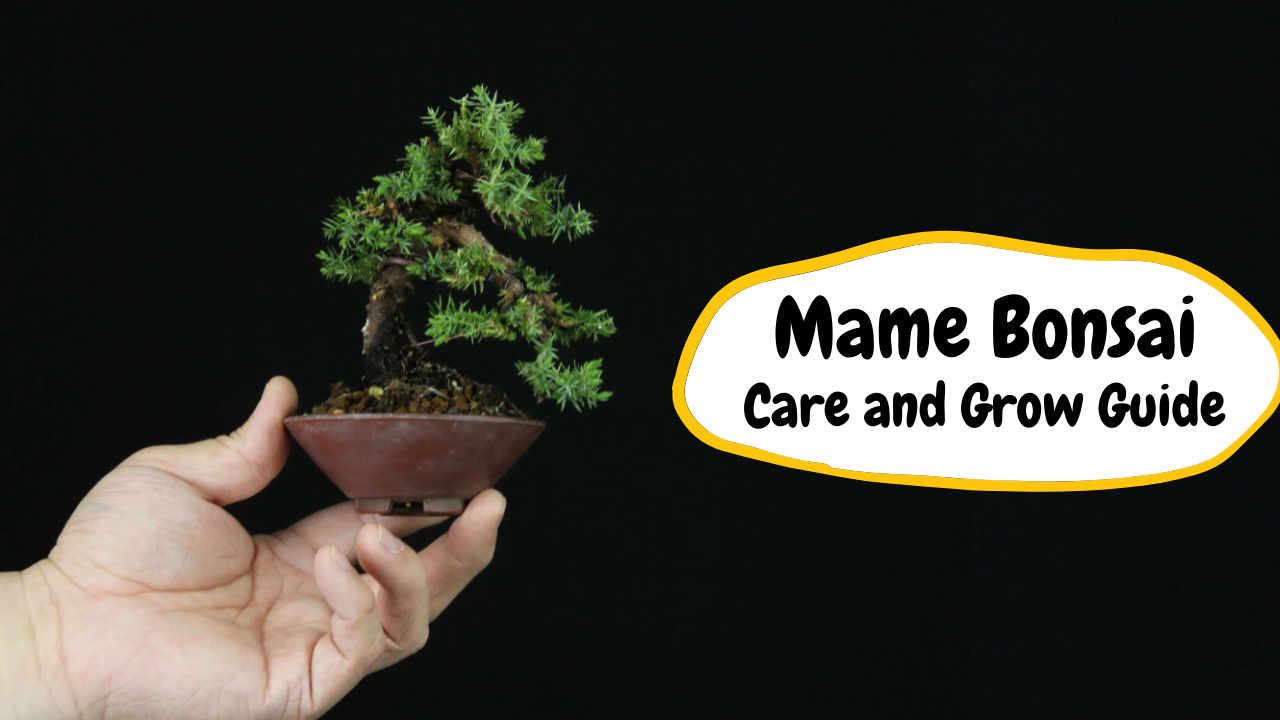Bring this 4-inch miniature to give your small place a touch of beauty. Mame, or miniature bonsai, is a great addition to a small apartment or house because of its compact size (often only 2-8 inches high).
Moreover, isn’t it interesting to know that despite being small in size, they are capable of bearing flowers and fruits just like the source tree?
Let’s discuss this miniature bonsai in detail and how to grow it quickly and easily. So, continue reading, and you’ll find this bonsai amusing.
What Is the Mame Bonsai?

Thousands of years ago, the Chinese introduced bonsai art to the world. Since then, many tree species have been cultivated as bonsai. According to their sizes, bonsai plants are classified.
Bonsai tree that can grow up to 5 feet high is called imperial bonsai, while their miniature counterparts that grow up to 15 cm only are called Mame bonsai.
A bonsai tree is considered Mame bonsai when it is grown between 3 to 5 years. During these years Mame plant develops its shapes. Moreover, it is important to know that the growth of the Mame bonsai plant is limited to a maximum of 6 inches.
To achieve this, extreme care and proper cultivation techniques should be applied. The care and cultivation technique will be further discussed in the later section of this article
Buying indoor bonsai plants online is a convenient and easy way to add a touch of nature to your indoor space. Many online retailers offer a wide variety of species and sizes, making it easy to find the perfect bonsai plant for your home or office. Before making a purchase, be sure to research the specific care requirements of your chosen plant to ensure it thrives in your space.
How to Grow Mame Bonsai Quickly
Seedling method
The easiest way to grow Mame bonsai quickly is from seedlings,
Step 1: Sow a pinch of the seed of your chosen species.
Step 2: When germination is completed, thin out the seeds as desired.
Step 3: All the extra seeds are removed for a single specimen. While for group planting, two to five are left to grow on.
Step 4: To avoid too much disturbance in the small container, while thinning the seeds, nip off the surplus seedlings with sharp scissors close to the soil surface.
Step 5: Pinch off the strongest seedlings early in the first season; this will encourage the growth of side shoots.
Step 6: Remove the lowest side shoots if you want a “clean” stem.
Step 7: Pinching the leaf is valuable for Mame bonsai as it not only corrects any overcrowding but also helps to check the growth and causes smaller leaves to be formed in the place of removed leaves.

Propagation method
Step 1: Choose the plant species that you want to grow. Select the one that thrives well in your location, and with the caring requirement you can easily meet. Remember, Mame bonsai are delicate. Therefore, you should commit to providing the proper care that the bonsai needs.
Step 2: Spring is the best time to do this as mini bonsai start to grow. For a higher success rate, follow the propagation methods specific to your selected species.
Step 3: While planting mini bonsai from a grown plant, carefully remove the plant without causing any damage to its complicated roots. Next, transfer the plant to your container with some of the original soil to cover the roots.
Step 4: To ensure enough moisture for the new plant, put some damp moss on top of the soil.
Step 5: In pots, you can select based on your preference. But make sure the pot has larger drainage holes to prevent the soil from being soaked with water.
Step 6: The next step is Pruning the Mame bonsai; this is crucial as it determines whether you have done the right thing. Pruning molds the plant into your desired shape. When you see new buds, try to trim them into two buds only until the bonsai achieves a desirable look.
Allow the branches to grow and prune those lengthier than the rest. If you want to style your bonsai, use simple guy wires depending on the species you are growing.
Once you have achieved the steps mentioned above, you may now follow caring routines. However, for the optimal growth of Mame bonsai, it is important that you follow regular watering, fertilizing, and repotting techniques.
How to Care for Mame Bonsai
Watering

The bonsai tree usually dies due to rapid drying or overwatering. But, surprisingly enough, it is over-watering that is responsible for most of the damage.
For this reason, plant your bonsai in an extremely sandy mixture and place your mini tree in a larger tray that holds damp sphagnum moss, sand, or gravel. So, when you water, the shallow tray will collect some water and promote humidity on hot days.
Water the bonsai plant whenever the topsoil feels dry to the palm. Do not allow the soil to become soggy.
Placement
Depending on your region’s weather conditions, you can grow Mame bonsai indoors and outdoors. But most bonsai plant species are outdoor varieties; they do not tolerate prolonged stays inside. Therefore, please keep them in an appropriately lit spot, such as on a patio or deck.
It’s best to place your miniatures in a sunny location, so they don’t become bone dry. For the optimal growth of the Mame plant, locate the plant at the spot that receives adequate sunlight and air for its utmost health. In addition, providing some protection against the sun is advisable on extremely hot days.
Soil
Good drainage and a fine grade of soil are important to encourage miniature to have a better-massed root system. However, it is also important to sieve the soil to remove fine silts, which would clog drainage holes and stop good aeration.
Fertilizer
While feeding, it is important to note that Mame bonsai do not require the same number of fertilizers as regular bonsai. It is recommended to inject a few quantities of fertilizers into the drainage holes on the base of the pots.
Pruning

To produce miniatures that look scaled, frequent trimming is vital. Make sure you use sharp tools and seal your cuts. You should also avoid cutting the bark when using wires. Wire marks on the bark will appear more clearly because of its small size.
Repotting

Repotting should be done annually. Try to remove as many of the older heavy roots as possible. This will encourage more fine feeder roots, which will make better use of the soil in the bonsai pot.
You may need to plant your miniatures in a slightly larger pot or in the ground for years to boost their vigor every few years.
Repotting is often needed for mini bonsai compared to regular bonsai. While doing this, prune the roots by a third of their original length. Large leaf species must be pruned to 50% of their leaves to avoid overgrowing and maintain their miniature shape.
Aftercare
In general, Mame bonsai will need the same kind of care as normal bonsai; however, it is recommended to place a bit of mulch on top for the first few weeks and maybe again for the height of your dry season.
It doesn’t matter what you use, as long as it keeps the surface moist without hindering oxygen exchange. This is so crucial step. Because if you don’t do this, the roots will grow straight down, limiting the amount of growth you can achieve in the pot before repotting becomes necessary again.
When the roots are covered with mulch, they will at first grow horizontally, but once they reach the pot’s rim, they will delve into the soil. As a result, they will maximize the pot space available.
Benefits of Mame Bonsai

- The Mame bonsai is the perfect fit for small apartments or houses as they have compact sizes.
- Despite being small, the plant bears beautiful flowers and fruits, just like its source tree.
- Many local nurseries sell bag trees at a reasonable price that can be used for budding Mame trees. Since Mame trees are smaller than usual bonsai trees, finding reasonably good material is not too difficult.
- Mame bonsai can be styled relatively quickly, so those who lack patience can work on Mame bonsai.
Conclusion
Mame bonsai plants are small does not mean you can neglect their caring requirements. Less size does not mean less care!
The Mame plant can live for at least three generations if you provide proper care to this mini one. Occasionally, your Mame bonsai can grow big despite taking all the care and attention.
When this occurs, you can choose to grow your Mame bonsai into standard-sized bonsai, as such bonsai are also widely popular. In addition, people pay a heavy price to obtain this Mame plant.
Before you go, make sure to check out our other beautiful bonsai posts!
Related Articles
- The Ultimate Guide to Buying Bonsai Plants: What to Look for and Where to Buy
- Boost Your Garden’s Health: 5 Key Reasons to Start Mulching Today
- Propagating Chinese Elm Bonsai Cuttings And From Seeds
- Best Chinese Elm Bonsai Soil and Fertilizer.
- Troubleshooting Common Problems With Chinese Elm Bonsai
- Buy Chinese Elm Bonsai: How Not to Get Scammed When Purchasing a Chinese Elm Bonsai Tree!




